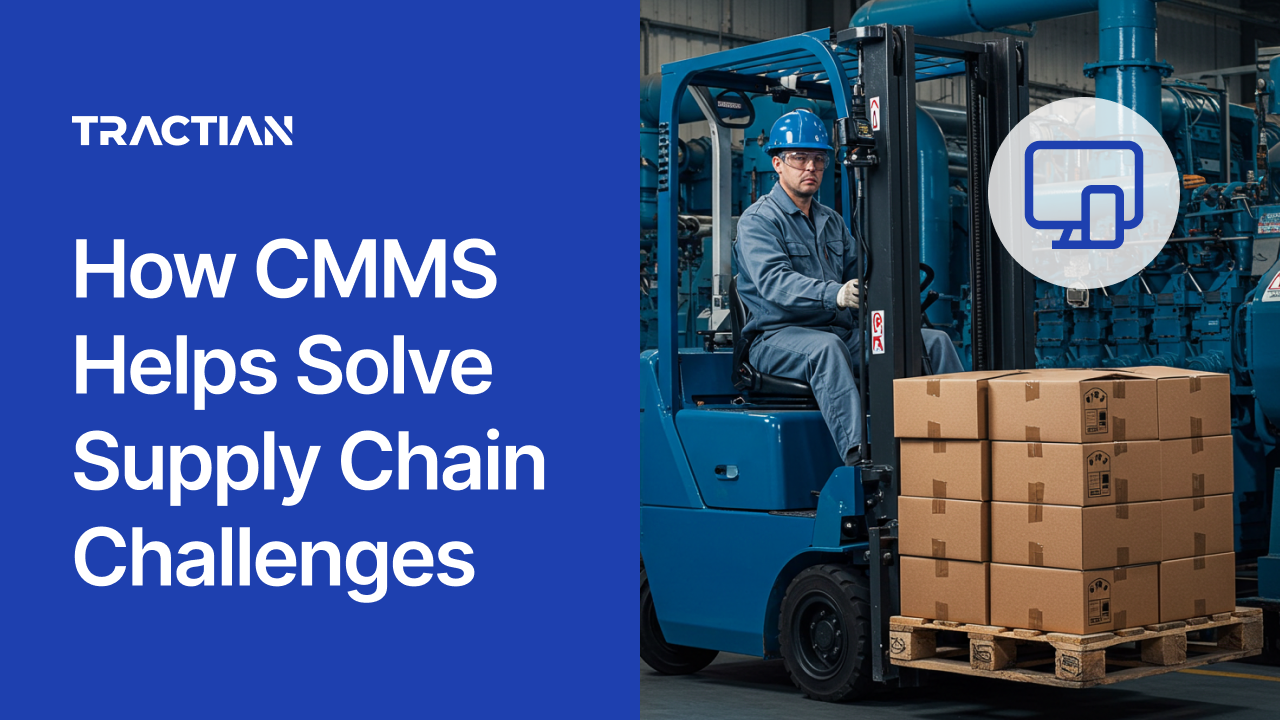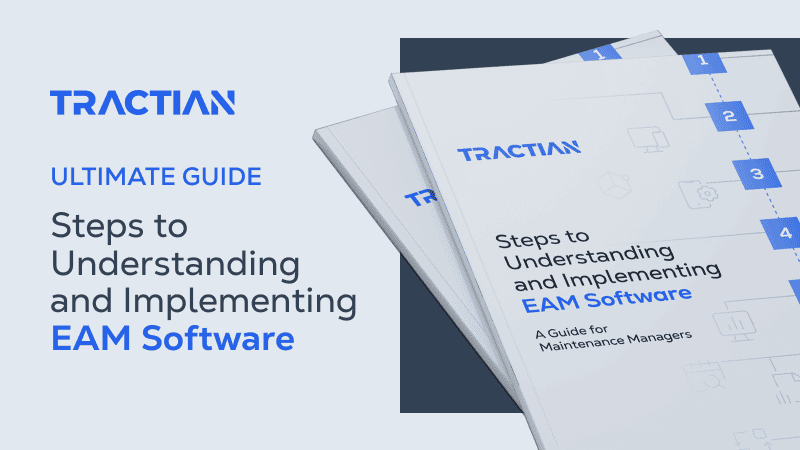Supply chain instability is at your door. Do you have a plan to navigate it? When a single missing part can stall production, or a supplier delay forces a complete shift in scheduling, maintenance is more than a support function. It becomes a frontline defense against disruption.
That’s where CMMS enters the conversation, not as a software, but as a coordination tool and visibility enabler. Because industrial operations without visibility operate at risk.
A CMMS provides structure in chaos. It ties parts availability to work order planning. It connects maintenance schedules with supplier lead times, and gives teams control over what they can’t afford to leave to chance.
In this article, we’ll explore how a CMMS empowers industrial maintenance teams to navigate supply chain challenges by preparing for them with clarity and precision.
What is a CMMS?
A CMMS (Computerized Maintenance Management System) is the operational command center for maintenance teams. It centralizes everything related to asset upkeep into a single digital environment.
But its value isn’t just in storing data. It’s in how the system connects that data to daily decision-making. When a part is low in stock or when an asset shows signs of repeat failure, the CMMS makes that clear immediately. Basically, it turns scattered information into something actionable.
This means maintenance no longer has to depend on gut feelings. Instead, everything is systematized, making all the difference between reactive work and strategic maintenance, especially when your supply chain is stretched thin.
What is Supply Chain Management?
Supply chain management is the coordination of every process involved in delivering a finished product, from sourcing raw materials to shipping the final unit.
In practice, supply chain management determines how quickly teams can respond when an asset goes down and a replacement part is needed. When this system runs smoothly, maintenance can stay proactive. But when it breaks, those gaps ripple straight into the plant floor.
This is why maintenance and supply chain teams are more connected than ever.
The Impact of CMMS on Supply Chain Management
When supply chains become unpredictable, maintenance can't afford guessing games. That's when lead times stretch or critical spares disappear overnight. And suddenly, the absence of a $50 component puts a $500,000 production line at risk.
A CMMS completely changes this by bringing maintenance into the supply chain conversation. Instead of reacting to shortages, teams can anticipate them with real-time data. Instead of overstocking just to play it safe, they align inventory levels with asset behavior and risk profiles.
This kind of software can not only track parts, but also:
- Synchronize procurement timelines with maintenance schedules
- Flag delays before they result in downtime
- Empower teams to close gaps with confidence.
Key Objectives of Effective Supply Chain Management
Supply chain management is a complex system designed to ensure that every material, component, and product moves through the value chain as efficiently and reliably as possible. The success of that system directly affects operational uptime, cost control, and the ability to execute maintenance strategies without compromise.
Here are the main goals driving high-performance supply chain management:
1. Minimize Lead Times Without Sacrificing Reliability
Shorter lead times reduce production risk, but only if the parts received meet your plant’s required specifications and quality standards. That balance between speed and reliability is critical. An efficient supply chain anticipates usage, builds reliable supplier networks, and incorporates contingency buffers where needed.
For maintenance, this means that critical spares arrive before failures happen, not after. It also means predictive maintenance efforts actually deliver, because the parts needed to act on insights are already in place.
2. Control Costs Across Procurement, Storage, and Logistics
True cost control means understanding the full financial footprint of sourcing, storing, and moving materials. That includes:
- Warehousing space
- Inventory obsolescence
- Rush shipping fees
- The cost of late or incorrect deliveries
Effective supply chain management connects those costs to operational decisions, helping maintenance teams identify which parts are worth stocking and where budget is being lost to inefficiencies.
3. Ensure Continuity and Availability of Critical Resources
When a bearing or sensor becomes unavailable, operations suffer. Continuity makes sure that doesn’t happen, and it requires redundancy in supplier relationships, plus proactively tracking usage trends.
Maintenance depends on continuity. If high-usage components run dry without a backup plan in place, the entire maintenance schedule suffers.
4. Enhance Visibility and Data Accuracy Across the Network
A supply chain built on incomplete or outdated data is prone to failure. Accurate information on things like stock levels and lead times enables better planning and faster reactions to disruptions.
Modern supply chain systems prioritize transparency, allowing maintenance to act more precisely. With connected systems and data accuracy, teams know exactly what’s available, what’s in transit, and what needs to be reordered.
5. Support Scalable and Resilient Operations
As production demands fluctuate, your supply chain has to be able to scale and adapt without introducing more chaos. This means building resilience into your processes and integrating supply planning with operational priorities.
In maintenance terms, scalability means growth doesn’t break your process. A new line or facility doesn’t derail your PM schedule. Instead, the supply chain grows with you, supported by the same system that helps you keep it under control.
Challenges in Supply Chain Management
For industrial operations, supply chain management is no longer a background function. It’s a high-stakes, high-visibility responsibility. That's because production hinges on having timely access to the right parts and materials.
Any delay in that chain immediately threatens your plant’s ability to stay on schedule. And when those delays hit, it’s the maintenance team that feels the pressure first.
Here’s where the real challenges show up for supply chain and maintenance leaders:
Lack of Real-Time Inventory Visibility
Inventory data that lags behind reality is a silent but deadly disruptor. When stock levels are inaccurate, maintenance teams either over-order and tie up capital, or under-order and get caught short.
This issue often stems from fragmented systems. Spreadsheets and outdated inventory software can’t track part movement in real time, creating blind spots that delay operations. For example, a technician opens a work order assuming a component is in stock, only to find out mid-task that it’s not.
Unpredictable Lead Times and Supplier Delays
Global logistics disruptions, regional shortages, and supplier backlogs have made lead times unreliable. Even parts with historically stable delivery windows can now fluctuate unpredictably.
Maintenance can’t function on unstable timelines. If a critical spare is delayed by two weeks and there’s no buffer stock, a single asset failure becomes a plant-wide production risk. And without clear, updated supplier performance data, teams can’t build reliable schedules, forcing them into reactive mode.
Overstocking and Excess Working Capital
Overstocking “just in case” might feel like you’re building a safety net, but it creates its own set of issues. Components age on the shelf, warranties expire, and your budget gets locked up in parts that may never actually be used.
What’s worse, excess inventory can create a false sense of readiness. You may have 500 parts in storage, but only 20 of them apply to assets on your current line. Without visibility into actual part criticality and consumption history, overstocking becomes expensive guesswork.
Disconnect Between Maintenance and Procurement
In many plants, maintenance planning and procurement operate in silos. Maintenance knows when a component will fail, but procurement doesn’t hear about it until the PO request hits. By then, the window to act strategically is gone.
This disconnect leads to rushed orders, inflated shipping costs, and misaligned part prioritization. When procurement doesn’t have access to the same asset data as maintenance, sourcing decisions can’t reflect real asset risk or usage frequency.
Limited Traceability and Compliance Exposure
Traceability matters, not just for quality assurance, but for compliance. Many industries require full documentation of things like part usage and supplier certification. Without an integrated system though, tracking that information becomes a manual, error-prone process.
In audits or failure investigations, missing traceability can lead to production holds, failed inspections, or worse, recalls. It’s not enough to know a component was replaced. Teams need to know which part, from which supplier, when it was installed, and why.
Data Fragmentation Across Tools and Departments
SCM systems, ERP software, CMMS platforms, and spreadsheets all collect slices of operational data, but rarely in a unified way. This fragmentation forces teams to reconcile data manually, slowing everything out.
Maintenance managers can’t forecast accurately. Buyers can’t prioritize effectively. Technicians waste time verifying part specs or chasing down stock location details. Without centralized, reliable data, decision-making stalls.
What Causes Supply Chain Disruptions in Manufacturing?
Disruptions in the manufacturing supply chain rarely come from a single source, they’re the result of systemic vulnerabilities and blind spots that stack up over time. For teams, understanding why disruptions occur is the first step to building more resilient, responsive systems.
Here are the most common causes of disruption in industrial manufacturing:
1. Supplier Instability and Single-Sourcing Risks
Relying on a limited number of suppliers, especially for critical components, creates immediate exposure. If one vendor fails, the entire flow of parts stops.
This is especially dangerous for hard-to-replace items or custom components. Without secondary sources or pre-qualified alternates, procurement teams are forced into emergency sourcing, driving up lead times and cost.
2. Poor Demand Forecasting and Inventory Planning
Forecasting errors are one of the most common sources of disruption. When projected usage doesn’t align with actual maintenance needs, stockouts and overstocking occur in cycles.
In manufacturing, this often happens when forecasts are based solely on historical data, without factoring in asset behavior or upcoming production shifts. If a predictive maintenance plan calls for increased replacements next quarter, but procurement doesn’t know that in advance, the chain breaks at the planning level.
3. Global Logistics Constraints
Delays and shortages all impact shipping timelines, especially for international suppliers. And these aren’t rare events anymore; they’re structural risks that need to be built into procurement strategies.
Manufacturers who rely heavily on offshore sourcing for spares or raw materials are particularly vulnerable. Even minor disruptions at one shipping hub can cascade into weeks-long delays, stalling planned maintenance work and disrupting production flow.
4. Lack of Synchronization Between Maintenance and Supply Chain
When maintenance and supply chain teams operate independently, neither side has the visibility to plan effectively. That disconnect leads to misaligned inventory, unplanned downtime, and repeated last-minute purchases. It also prevents both teams from responding quickly when failures occur or plans shift.
5. Regulatory and Compliance-Related Delays
In regulated industries like food and pharma, every part and supplier must meet specific standards. When documentation is missing or a certification expires, parts get stuck in limbo, even if they’re physically available.
These delays often go unflagged until they block a scheduled repair or trigger a failed audit. And without centralized systems to track critical data, compliance itself becomes a supply chain risk.
6. Unplanned Asset Failures and Maintenance Backlogs
Sometimes disruption doesn’t come from the outside, it starts inside your plant. When a critical machine fails unexpectedly and the part isn’t on hand, procurement scrambles, and production halts.
This chain reaction happens when maintenance strategies don’t account for supply readiness. A failure may be predictable from a reliability standpoint, but if the part wasn’t pre-ordered, or if inventory wasn’t updated after the last use, it becomes a supply chain crisis.
7. Inaccurate or Incomplete Data Across Systems
Disconnected systems generate unreliable data. If inventory levels in the CMMS aren’t synced with actual stock, or if procurement doesn’t receive real-time updates from maintenance, decisions are based on guesswork.
Data fragmentation prevents teams from identifying patterns, such as consistent delivery delays or rising part failure rates that would otherwise inform strategic shifts.
4 Ways a CMMS Helps Supply Chain Maintenance Managers Reduce Operating Costs
Operating costs in manufacturing are tightly linked to how well maintenance and supply chain functions work together. Any missed reorders or emergency purchases drive expenses up fast.
For maintenance managers responsible for cost control, a well-implemented CMMS is a vital lever for operational efficiency and budget stability.
Here’s how it works in practice:
1. A CMMS Eliminates Emergency Purchasing with Accurate Stock Forecasting
Emergency orders don’t just carry higher shipping costs, they’re also less strategic. For example, you could lose negotiating power or introduce procurement delays that could’ve been avoided with better planning.
A CMMS tracks part usage in real time, tying each part to specific assets, work orders, and usage history. This allows maintenance managers to identify fast-moving items, project future demand, and automate reorder triggers.
2. It Reduces Downtime-Related Costs with Improved Part Availability
When unplanned downtime is caused by missing parts, costs skyrocket, not just in lost production, but in wasted labor hours and delayed shipments.
But with a CMMS, part availability is validated before a work order is even assigned. Technicians can see what’s in stock, and planners can adjust schedules based on what’s ready to go.
This shifts the plant from reactive triage to controlled execution. Downtime windows shrink, labor gets used more efficiently, and assets return to service faster.
3. It Connects Maintenance Priorities with Procurement Decisions
Maintenance knows which assets are high risk. Procurement knows how to manage supplier relationships and optimize costs. But without shared data, both teams operate in isolation .
A CMMS bridges these silos, providing visibility into asset criticality, failure trends, and part demand directly from the maintenance side. That insight empowers procurement to focus on sourcing the parts that actually matter, reducing waste, and improving supplier performance.
For example, if a compressor’s vibration history shows a pattern of bearing degradation every 4,000 hours, the CMMS will reflect that. Procurement can then proactively stock that bearingbecause it’s no longer an unpredictable need.
4. It Improves Wrench Time and Labor Efficiency
Labor is one of the most underleveraged cost factors in maintenance operations. Technicians often spend a significant percentage of their time waiting for approvals and hunting for parts.
A CMMS cuts through that inefficiency by streamlining workflows. For example, work orders now include complete BOMs, attached SOPs, and live inventory checks. That structure increases wrench time, helping more labor hours go toward actual maintenance, not paperwork or waiting. It also reduces overtime, minimizes rescheduled work, and prevents double-handling of tasks due to missing resources.

Integration Capabilities of Inventory Management CMMS Software
Integration starts with procurement. A CMMS that links with ERP or purchasing systems ensures that part consumption on your floor is reflected in real-time within sourcing workflows.
For example, when a technician completes a work order, the system can automatically reduce inventory counts, trigger reorder alerts, or even generate purchase requisitions. This way, purchasing always stays ahead of demand.
It also connects with production planning systems. Maintenance activities, especially those requiring parts replacement, can be aligned with production windows. For example, if a line shutdown is scheduled, the CMMS can coordinate part availability and maintenance timing to avoid interfering with operational goals.
This kind of synchronization avoids overlapping downtime, reducing unnecessary interruptions to output.
On the maintenance side, integration with asset monitoring tools adds another layer of intelligence. When condition monitoring identifies a trend toward failure, the CMMS automatically checks part availability and preloads the necessary materials into an upcoming work order.
This closes the loop between predictive maintenance and supply readiness, turning insights into action.
How Tractian's CMMS Helps With Supply Chain
For supply chain and maintenance leaders, the gap between planning and execution usually shows up when it’s too late. Every delayed part and missed reorder becomes a bottleneck that slows production and drives up cost.
A modern CMMS closes those gaps, making sure every decision is backed by real data.
Tractian’s CMMS aligns with supply chain performance at every level. From real-time part tracking to reorder automation, Tractian ensures the resources you need are where they should be.
We’ve designed our system to make asset reliability, inventory control, and supply planning work together. No spreadsheets, no disconnected systems. Just one platform that gives you visibility, coordination, and control. And, it all comes with an easy and free onboarding process.



